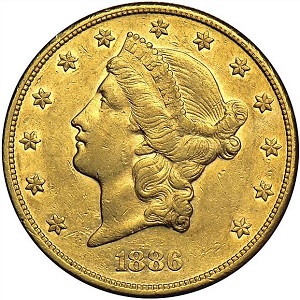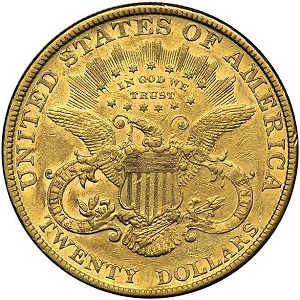1886 Coronet $20 Double Eagle
Many historians agree the Civil War of 1861-1865 was the most consequential event in American history. The ramifications of that conflict extended far, including into the United States monetary system, where its impact was still being felt more than two decades after Lee’s surrender at Appomattox Court House.
In late 1861, the U.S. government suspended specie payments for the redemption of paper money, to preserve gold and silver in the nation’s coffers. That step was taken because after a few months of battlefield results, it became clear the struggle between the North and South was not going to be settled anytime soon.(1)
Starting in 1862, the Treasury Department issued legal tender notes dubbed “Greenbacks.” It was fiat money, supported only by the credibility of the federal government. The trading value of a Greenback dollar vacillated, never reaching par with a dollar’s worth of gold. By war’s end, a total of $431 million in Greenbacks had been issued, but a Greenback dollar was worth just 78 cents in gold.(2)
Although the hostilities ended in 1865, the Greenbacks continued to circulate. In 1875, Congress passed the Specie Resumption Act, mandating the Treasury Secretary to redeem in gold all Greenbacks presented to the Treasury on or after January 1, 1879.
Anticipating redemptions on a vast scale, Treasury built up gold reserves, much of it in the form of $20 double eagles. But then something unexpected happened: by the time 1879 rolled around, the Greenback had finally attained equal footing with gold. Most Greenback holders didn’t bother to exchange their paper for hard currency.(3)
With a glut of double eagles on hand and little demand for more, production of the $20 coin plummeted drastically during the 1880s at the Philadelphia Mint. Instead, manufacturing capacity was prioritized for Morgan dollars and smaller gold denominations. In the West, where new twenties were still needed, output remained high at the San Francisco Mint.(4)(5)
Only 1,000 business strike double eagles were minted at Philadelphia in 1886, with all of them eventually released into circulation. Contemporary coin collectors had scant interest in them, preferring Proof representatives instead, of which 142 were distributed. This explains why so few Mint State specimens of the 1886 double eagle exist today.(6)
An oddity surrounding the 1886 is that it was the only Coronet double eagle date that was struck exclusively at the Philadelphia Mint: none were issued from any branch mint. A rather remarkable statement for a coin type that was produced for nearly sixty years, from 1850 to 1907.
Today, the 1886 Coronet double eagle is recognized as one of the greatest prizes in numismatics, often mentioned in the same breath as the legendary 1854-O, 1856-O, and the 1870-CC double eagles.(7)
Not bad for a coin that once upon a time long ago, no one wanted.
| Estimated survivors in all grades: 68 ?
The survivor estimate from PCGS represents an average of one or more experts' opinions as to how many examples survive of a particular coin in all grades. Survival estimates include coins that are raw, certified by PCGS, and certified by other grading services. Learn more at PCGS. |
| PCGS Rarity Scale: 8.3 ?
The 'PCGS CoinFacts Rarity Scale' assesses the relative rarity of all U.S. coins, based on estimated surviving examples. The scale runs from 1.0 to 10.0. The higher the number, the rarer the coin.
Learn more at PCGS. |
| Click HERE to check for availability on eBay** |
Preview of eBay selection (you may have more success finding an 1886 $20 through the HERE link above):
 |
 |
| Trendline Avg = 19.13 | BETTER |
Historic Value Trend Charts:
| Last updated 10-9-24 | Return to Key Date Coin List | |
| Compare to Common Date Coin of Same Type | ||
|
|
||
| Download Charts to Your Computer | ||
Sources
1. Wikipedia. Specie Payment Resumption Act.
2. Todd, Lewis P. and Curti, Merle. Rise of the American Nation, 3rd ed. New York, NY: Harcourt Brace Jovanovich, Inc., 1972.
3. Taxay, Don. The U.S. Mint and Coinage. New York, NY: Sanford J. Durst Numismatic Publications, 1966.
4. Stack's Bowers Galleries. 1886 Coronet $20 Double Eagle. Jan 2008 Auction.
5. Heritage Auctions. 1886 $20. Apr 2015 Auction.
6. Heritage Auctions. 1886 $20. Jan 2020 Auction.
7. Stack's Bowers Galleries. 1886 Coronet $20 Double Eagle. Sep 2003 Auction.
**Many very fine coin dealers sell on eBay. At any point in time, there may be over one million search results for United States coins. This includes quite a few of the recommendations on our Key Date Coin List.
If you’re thinking about purchasing a rare coin, eBay is certainly worth a look. For your convenience, the links from this site to eBay are coded to bring up only coins certified by PCGS and NGC.
As is always, always the case, never buy a valuable coin from a seller whose trustworthiness cannot be verified. Learn more about this at our chapter Best Places to Buy Coins, which also has a section on doing business on eBay.
In the interest of full disclosure, Rare Coins 101 receives a small commission anytime someone connects to eBay from this site and purchases something.
Coin images by Stack's Bowers Galleries.


